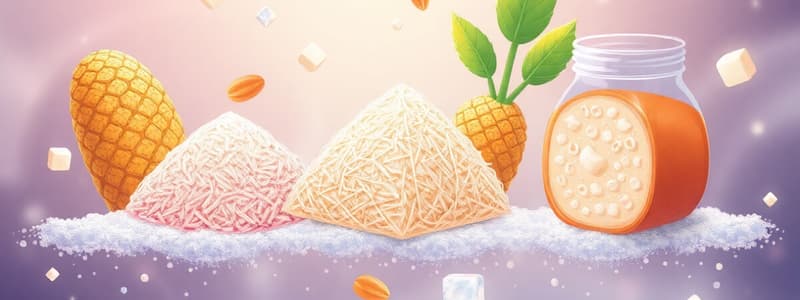Podcast
Questions and Answers
What is the primary source of sweetness in honey?
What is the primary source of sweetness in honey?
- Glucose
- Galactose
- Maltose
- Fructose (correct)
Which disaccharide is known as milk sugar?
Which disaccharide is known as milk sugar?
- Glucose
- Sucrose
- Lactose (correct)
- Maltose
Which of the following disaccharides is formed from the combination of two glucose molecules?
Which of the following disaccharides is formed from the combination of two glucose molecules?
- Sucrose
- Fructose
- Lactose
- Maltose (correct)
What is the predominant carbohydrate found in cereal grains?
What is the predominant carbohydrate found in cereal grains?
Which oligosaccharide is formed from three monosaccharide molecules?
Which oligosaccharide is formed from three monosaccharide molecules?
Which amino acid is considered limiting in cereal grains?
Which amino acid is considered limiting in cereal grains?
What are the main components of sucrose?
What are the main components of sucrose?
What is true about human milk compared to cow's milk concerning lactose content?
What is true about human milk compared to cow's milk concerning lactose content?
Why are B vitamins added back to cereal grains during processing?
Why are B vitamins added back to cereal grains during processing?
What percentage of the kernel do lipids typically represent in cereal grains?
What percentage of the kernel do lipids typically represent in cereal grains?
Which product primarily uses maltose in its production?
Which product primarily uses maltose in its production?
Which sugar molecule is least likely to occur in its monosaccharide form in foods?
Which sugar molecule is least likely to occur in its monosaccharide form in foods?
What characteristic is NOT associated with Hard wheat?
What characteristic is NOT associated with Hard wheat?
Whole grains naturally contain higher levels of which nutrients compared to refined grains?
Whole grains naturally contain higher levels of which nutrients compared to refined grains?
Which of the following describes the protein content and water absorption power of Soft wheat?
Which of the following describes the protein content and water absorption power of Soft wheat?
What role does the fortification of cereal grains serve?
What role does the fortification of cereal grains serve?
What is the primary purpose of the enrichment process in rice?
What is the primary purpose of the enrichment process in rice?
Which component of flour is primarily responsible for its elastic properties?
Which component of flour is primarily responsible for its elastic properties?
Which amino acids are corn particularly lacking in?
Which amino acids are corn particularly lacking in?
What is the ideal gluten content for cake and biscuit flour?
What is the ideal gluten content for cake and biscuit flour?
How can the nutrient retention be ensured during rice processing?
How can the nutrient retention be ensured during rice processing?
Which statement about whole rice compared to polished rice is accurate?
Which statement about whole rice compared to polished rice is accurate?
What is a common use of corn in culinary applications?
What is a common use of corn in culinary applications?
Which vitamins are commonly added during the enrichment of rice?
Which vitamins are commonly added during the enrichment of rice?
What is a key limitation of green flour?
What is a key limitation of green flour?
Which chemical is NOT commonly used as a bleaching agent in flour processing?
Which chemical is NOT commonly used as a bleaching agent in flour processing?
What environmental factor contributes to the classification of wheat as red or white?
What environmental factor contributes to the classification of wheat as red or white?
What is the primary purpose of maturing flour?
What is the primary purpose of maturing flour?
Which of the following statements about starch is true?
Which of the following statements about starch is true?
How does higher moisture content affect flour storage?
How does higher moisture content affect flour storage?
Which milling method is characterized by producing flour suitable for home use?
Which milling method is characterized by producing flour suitable for home use?
What is the effect of oxidation in the bleaching process?
What is the effect of oxidation in the bleaching process?
Which type of polysaccharide is primarily responsible for providing structural strength to plant cell walls?
Which type of polysaccharide is primarily responsible for providing structural strength to plant cell walls?
What is the primary property of pectin when fruit becomes overripe?
What is the primary property of pectin when fruit becomes overripe?
Which of the following is true about hemicelluloses?
Which of the following is true about hemicelluloses?
Which type of fiber is characterized as being viscous when mixed with water and is known as a laxative component?
Which type of fiber is characterized as being viscous when mixed with water and is known as a laxative component?
What role do gums and mucilages play in plants?
What role do gums and mucilages play in plants?
Which statement is NOT true about lignins?
Which statement is NOT true about lignins?
What is the primary use of plant gums in the food industry?
What is the primary use of plant gums in the food industry?
Which of the following plant-based foods is a rich source of dietary fiber?
Which of the following plant-based foods is a rich source of dietary fiber?
Flashcards are hidden until you start studying
Study Notes
Monosaccharides
- Fructose is the primary source of honey's sweet taste
- Galactose is rarely found as a monosaccharide in food
- Galactose is commonly bonded to glucose to form lactose, the primary sugar found in milk and dairy products
Disaccharides
- Disaccharides consist of two monosaccharides linked together
- Sucrose (table sugar) is composed of one glucose molecule and one fructose molecule
- Lactose (milk sugar) is composed of one glucose molecule and one galactose molecule
- Human milk has a higher concentration of lactose than cow's milk, making it sweeter
- Maltose is composed of two glucose molecules
- Maltose is formed during starch digestion
- Maltose is fermented to produce beer
Oligosaccharides
- Oligosaccharides are short carbohydrate chains of 3 to 10 sugar molecules
- Raffinose and stachyose are the most common oligosaccharides found in dried beans, peas, and lentils
- Raffinose is composed of one galactose, one glucose, and one fructose molecule
- Stachyose is composed of two galactose, one glucose, and one fructose molecule
- Whole grains, legumes, fruits, and vegetables are rich sources of dietary fiber
Polysaccharides
- Cellulose is made up of long, straight chains of glucose molecules
- Cellulose provides structural strength to plant cells
- Hemeicelluloses are composed of various monosaccharides with many branching side chains
- Hemeicelluloses are found in cereal grains, legumes, vegetables, and nuts
- Pectins are gel-forming polysaccharides found in all plants, especially fruits
- Pectins break down into monosaccharides as fruits ripen, making them mushy
- Gums and mucilages are thick, gel-forming fibers that hold plant cells together
- Psyllium (husk of psyllium seeds) forms a viscous gel when mixed with water
- Lignins are indigestible substances that make up the woody parts of vegetables and fruits
- Lignins are not carbohydrates
Soluble and Insoluble Fiber
- Soluble fiber dissolves in water and forms gels
- Insoluble fiber does not dissolve in water and adds bulk to stools
- Soluble fiber helps lower cholesterol and control blood sugar levels
- Insoluble fiber helps prevent constipation
- Both types of fiber contribute to a feeling of fullness
Cereal Grains
- The dry matter of grain is composed of 79-83% carbohydrates, primarily in the form of starch
- The lipid content of grain is 1-7%
- Cereal grains are low in the amino acids tryptophan, methionine, and lysine
- Cereal grains are a good source of B vitamins, including thiamin, riboflavin, and niacin
- Whole grains contain higher mineral levels than refined grains
- Flour with a higher protein content absorbs more water
Wheat
- Wheat is classified according to type, color, and hardness
- Hard wheat has higher protein content, absorbs more water, and has better mixing capacity
- Soft wheat has lower protein content, absorbs less water, and has poor mixing capacity
- Red wheat and white wheat have color variations based on environmental factors
- The milling process converts wheat into flour
- Flour obtained after milling is called green flour and has high moisture content and a yellowish hue
- Bleaching removes the color of flour through oxidation using chlorine, chlorine dioxide, or benzyl peroxide
- Maturing improves flour quality through oxidation using potassium bromate or ascorbic acid
Wheat Flour Composition
- Starch gelatinizes when heated with water
- Starch, lipid, and gluten combine to retain gas during fermentation
- Flour moisture content affects storage life, insect infestation, and water absorption
- Flour contains soluble and insoluble proteins, including albumin, globulin, gliadin, and glutenin
- Gluten content determines flour quality, with 10-11.5% for bread making and 7-10% for cakes and biscuits
Rice
- Rice is a staple food for half the world's population
- Whole rice is more prone to rancidity, deterioration, and insect infestation than polished white rice
- Enriched rice should not be rinsed before cooking to retain added vitamins and minerals
Corn
- Corn is a staple food and also used for animal feed
- Corn lacks the essential amino acids tryptophan and lysine
- Corn flour is often blended with wheat flour for bread making
Studying That Suits You
Use AI to generate personalized quizzes and flashcards to suit your learning preferences.




